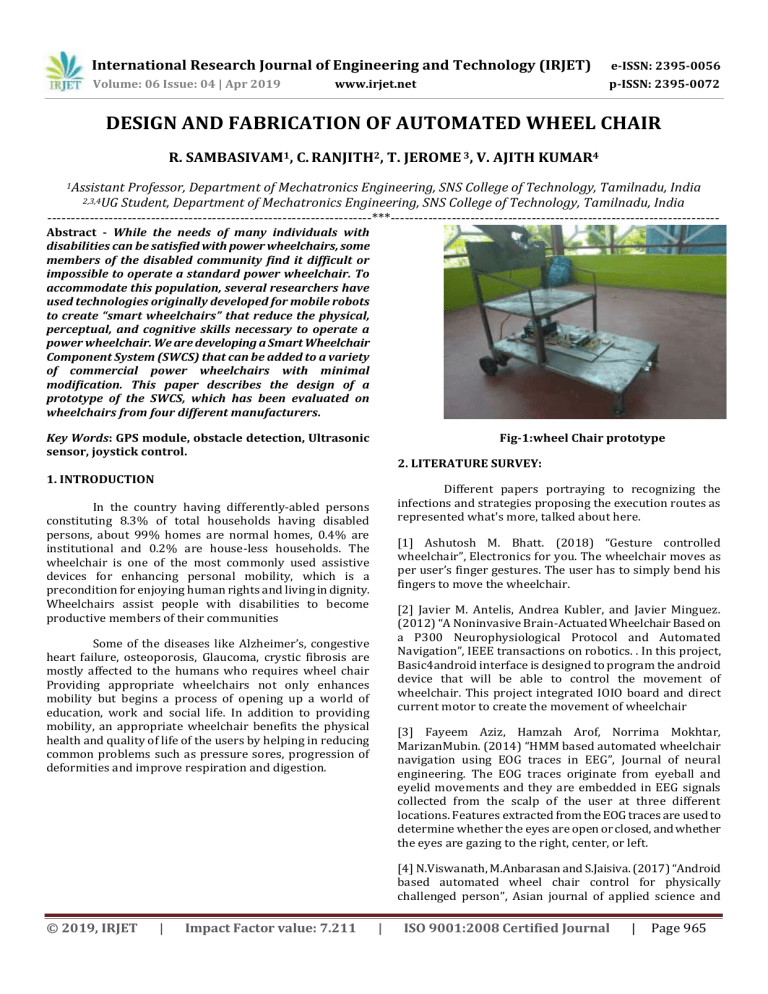IRJET-Design and Fabrication of Automated Wheel Chair
advertisement

International Research Journal of Engineering and Technology (IRJET) e-ISSN: 2395-0056 Volume: 06 Issue: 04 | Apr 2019 p-ISSN: 2395-0072 www.irjet.net DESIGN AND FABRICATION OF AUTOMATED WHEEL CHAIR R. SAMBASIVAM1, C. RANJITH2, T. JEROME 3, V. AJITH KUMAR4 1Assistant Professor, Department of Mechatronics Engineering, SNS College of Technology, Tamilnadu, India Student, Department of Mechatronics Engineering, SNS College of Technology, Tamilnadu, India ---------------------------------------------------------------------***---------------------------------------------------------------------2,3,4UG Abstract - While the needs of many individuals with disabilities can be satisfied with power wheelchairs, some members of the disabled community find it difficult or impossible to operate a standard power wheelchair. To accommodate this population, several researchers have used technologies originally developed for mobile robots to create “smart wheelchairs” that reduce the physical, perceptual, and cognitive skills necessary to operate a power wheelchair. We are developing a Smart Wheelchair Component System (SWCS) that can be added to a variety of commercial power wheelchairs with minimal modification. This paper describes the design of a prototype of the SWCS, which has been evaluated on wheelchairs from four different manufacturers. Key Words: GPS module, obstacle detection, Ultrasonic sensor, joystick control. Fig-1:wheel Chair prototype 2. LITERATURE SURVEY: 1. INTRODUCTION Different papers portraying to recognizing the infections and strategies proposing the execution routes as represented what's more, talked about here. In the country having differently-abled persons constituting 8.3% of total households having disabled persons, about 99% homes are normal homes, 0.4% are institutional and 0.2% are house-less households. The wheelchair is one of the most commonly used assistive devices for enhancing personal mobility, which is a precondition for enjoying human rights and living in dignity. Wheelchairs assist people with disabilities to become productive members of their communities [1] Ashutosh M. Bhatt. (2018) “Gesture controlled wheelchair”, Electronics for you. The wheelchair moves as per user’s finger gestures. The user has to simply bend his fingers to move the wheelchair. [2] Javier M. Antelis, Andrea Kubler, and Javier Minguez. (2012) “A Noninvasive Brain-Actuated Wheelchair Based on a P300 Neurophysiological Protocol and Automated Navigation”, IEEE transactions on robotics. . In this project, Basic4android interface is designed to program the android device that will be able to control the movement of wheelchair. This project integrated IOIO board and direct current motor to create the movement of wheelchair Some of the diseases like Alzheimer’s, congestive heart failure, osteoporosis, Glaucoma, crystic fibrosis are mostly affected to the humans who requires wheel chair Providing appropriate wheelchairs not only enhances mobility but begins a process of opening up a world of education, work and social life. In addition to providing mobility, an appropriate wheelchair benefits the physical health and quality of life of the users by helping in reducing common problems such as pressure sores, progression of deformities and improve respiration and digestion. [3] Fayeem Aziz, Hamzah Arof, Norrima Mokhtar, MarizanMubin. (2014) “HMM based automated wheelchair navigation using EOG traces in EEG”, Journal of neural engineering. The EOG traces originate from eyeball and eyelid movements and they are embedded in EEG signals collected from the scalp of the user at three different locations. Features extracted from the EOG traces are used to determine whether the eyes are open or closed, and whether the eyes are gazing to the right, center, or left. [4] N.Viswanath, M.Anbarasan and S.Jaisiva. (2017) “Android based automated wheel chair control for physically challenged person”, Asian journal of applied science and © 2019, IRJET | Impact Factor value: 7.211 | ISO 9001:2008 Certified Journal | Page 965 International Research Journal of Engineering and Technology (IRJET) e-ISSN: 2395-0056 Volume: 06 Issue: 04 | Apr 2019 p-ISSN: 2395-0072 www.irjet.net technology (AJAST).used beagle bone black, GSM technology, colour convertion, HSV conversion, morphological image processing, Bhattacharyya distance algorithms, relay. The SIAMO project began at the end of 1996 as a continuation of a previous project financed by the ONCE Foundation (National Organization for the Blind of Spain), user-chair interfaces based on oral commands (isolated words with a user-dependent engine), a joystick, and a sensory system composed of ultrasonic and infrared sensors that allowed the detection of obstacles and abrupt unevenness (such as stairs, etc.) [5] Mohammed Asgar, Mirza Badra, Khan Irshad and Shaikh Aftab. (2013) “Automated innovative wheelchair”, International Journal of Information Technology Convergence and Services (IJITCS) In modern technology, the HMI based techniques include joysticks controller, finger movement, voice recognition, eye-gaze tracking, electromyography, etc. Fig-3 Joystick Module (Source: Google Images) 3.3 16 x 2 LCD Display The LCD Display is the electronic device. The LCD display used to see the sicknesses distinguished or ailments name are shown from the LCD. 3. HARDWARE The Real time smart wheelchair is based upon some of the hardware components by developing the process. 3.4 Power Supply 3.1 PIC 16F877 The Raspberry pi board need the 5V and 3A power supply to working condition.so, they used to the 5V power supply adapter used to power supply to the raspberry pi board. The microcontroller that has been used for this project is from PIC series. PIC microcontroller is the first RISC based microcontroller fabricated in CMOS (complimentary metal oxide semiconductor) that uses separate bus for instruction and data allowing simultaneous access of program and data memory. 3.5 DC MOTOR 12V 55Rpm DC Wiper Motor - ZKE1032 – Left is commonly used as wiper motor for cars, but it can also be used in the field vehicles and projects that require high power. The motor speed is 55rpm and because of the bearing used it has no problem with longer operation times. The motor has 6mm screw holes for mounting and its gear is designed to be on left side of the motor. 3.6 ULTRASONIC SENSOR Fig- PIC16F877(Source: Google Images) 3.2 Joystick It emits an ultrasound at 40 000 Hz which travels through the air and if there is an object or obstacle on its path It will bounce back to the module. Considering the travel time and the speed of the sound you can calculate the distance. The module gives analog output so it can be used for feeding the analog input based on direction or movement. It can also be connected to a movable camera to control its movement. We can use a Joystick Module with Arduino, Raspberry Pi and any other Micro-controllers. 3.7 Global Positioning System It is the only fully functional GNSS in the world, can be used freely, and is often used by civilians for navigation purposes. It uses a constellation of between 24 and 32 Medium Earth Orbit satellites that transmit precise microwave signals, which allow GPS receivers to determine their current location, the time, and their velocity. © 2019, IRJET | Impact Factor value: 7.211 | ISO 9001:2008 Certified Journal | Page 966 International Research Journal of Engineering and Technology (IRJET) e-ISSN: 2395-0056 Volume: 06 Issue: 04 | Apr 2019 p-ISSN: 2395-0072 www.irjet.net 4. Methodology REFERENCES The ailments distinguishing proof procedure is utilized to MPlab software. The MPlab Software is the one of the microcontroller processing, programming or library. By using the PIC16f877 microcontroller in the way of controlling the DC motor with the help of DC drive after math Human beings get sophisticated motion. [1] Ashutosh M. Bhatt. (2018) “Gesture controlled wheelchair”, Electronics for you. 5. HARDWARE SIMULATION: [3] Fayeem Aziz, Hamzah Arof, Norrima Mokhtar, MarizanMubin. (2014) “HMM based automated wheelchair navigation using EOG traces in EEG”, Journal of neural engineering. [2] Javier M. Antelis, Andrea Kubler, and Javier Minguez. (2012) “A Noninvasive Brain-Actuated Wheelchair Based on a P300 Neurophysiological Protocol and Automated Navigation”, IEEE transactions on robotics. When the Joystick controller is turned ON, as like the mechanism of the potentiometer, it activates DC drive towards the DC motor to control the changing direction of Wheel Chair. In between connection of GPS module and LCD display all information and latitude, longitude. If the object is detected the wheelchair takes right and moves 50 cm and turns right and moves forward at a distance of 20 cm and stopped. When we press the switch nearby the joystick it shows the GPS location of the patient. [4] N.Viswanath, M.Anbarasan and S.Jaisiva. (2017) “Android based automated wheel chair control for physically challenged person”, Asian journal of applied science and technology (AJAST). [5] Mohammed Asgar, Mirza Badra, Khan Irshad and Shaikh Aftab. (2013) “Automated innovative wheelchair”, International Journal of Information Technology Convergence and Services (IJITCS). LCD display shows information are obstacle deducted, Lat, Long, Right, Left, Backward, Forward. When obstacle deducted the wheel chair get turn right and hold some minutes [6] Akar Jain, Dhaval Petiwala, Prakash Narayan, Shantanu Shobhit. (2017) “Automated wheel-chair on eyebrow movements using brain wave sensor by EEG” international journal of multidisciplinary research and development. [7] Utkarsh Sinha, Kanthi.M. (2016) “Mind controlled wheelchair”, International science press [8] Rajavenkatesan.T, Nagalakshmi.S. (2015) “Innautomatic wheelchair using eyeball sensor”, international journal of advanced technology in engineering and science. [9] Chin-Tuan Tan and Brian C. J. Moore. (2008) “Perception of nonlinear distortion by hearing-impaired people”, International Journal of Ideology. Fig-4 Circuit Design and Simulation [10] Oberle, S., and Kaelin. (1995) “Recognition of acoustical alarm signals for the profoundly deaf using hidden Markov models”, IEEE International symposium on Circuits and Systems (Hong Kong). 6. CONCLUSION: Our wheelchair can be made which can be operated by a Joystick. Output of sensor can be applied to wire transmitter circuit and can received at wheelchair circuit by receiver circuitry. So, GPS module operation can arrange and display the information. Instead of using acceleration motion (eyebrow Movement), in future we can use IOT based human machine interface to move wheelchair in different direction. Using retina movement, we would be able to drive a wheelchair. We can use voice command IC to interface our voice signals with microcontroller. [11] Shawki and Z. J. (2001) “smart reconfigurable visual system for the blind”, Proceedings of the Tunisian-German Conference on: Smart Systems and. [12] M. Higgins and V. Pant. (2004) “Biomimetic VLSI sensor for visual tracking of small moving targets” , IEEE Transactions on Circuits and Systems. [13] Daerden and D. Lefeber. (2001) “The concept and design of pleated pneumatic artificial muscles”, International Journal of Fluid Power. [14] K. R. Castle man. (1996) “Digital Image Processing”, Pearson Education. © 2019, IRJET | Impact Factor value: 7.211 | ISO 9001:2008 Certified Journal | Page 967 International Research Journal of Engineering and Technology (IRJET) e-ISSN: 2395-0056 Volume: 06 Issue: 04 | Apr 2019 p-ISSN: 2395-0072 www.irjet.net [15] M. A. Mazidd. (2008) “AVR micro controller and Embedded Systems”, http://electronics.howstuffworks.com/gadgets /high- techgadgets/speech-recognition.htm [28] Leslie J. (2004)” Analysis of automated online GPS processing services”, B.Sc.E. report, Department of Geodesy and Geomatics Engineering, University of New Brunswick, Fredericton, NB, Canada [16] D. Murray and A. Basu. (1994) “Motion tracking with an active camera”, IEEE Trans. Pattern Analysis and Machine Intelligence. [29] Michael Sivak and Brandon Schoettle. (2015) “Potential Impact of Self-Driving Vehicles on Household Vehicle Demand and Usage”, Sustainable Worldwide Transportation Program (www.umich.edu/~umtriswt), University of Michigan. Also see, Influence of Current Nondrivers on the Amount of Travel and Trip Patterns with Self-Driving Vehicles, at www.umich.edu/~umtriswt/PDF/UMTRI-201539_Abstract_English.pdf. [17] N. Otsu. (1979) “A threshold selection method from gray-level histogram”, IEEE Trans. System, Man, and Cybernetic. [18] N. M. Z. Hashim, M. H. A.Halim, H.Bakri. (2013) “Vehicle Security System Using Zigbee”, International Journal of Scientific and Research Publications. [30] Tom Simonite. (2016), “Prepare to be Underwhelmed by 2021’s Autonomous Cars: Ford, Uber, and BMW Promise Fully Self-Driving Cars in Five Years—But They Will Probably Only Work in Very Limited Areas”, MIT Technology Review (www.technologyreview.com); at https://bit.ly/2PZxH6X. [19] S. H. Husin, A. A. Ngahdiman, N. M. Z. Hashim, Y. Yusop, A. S. Ja‟afar. (2013) “Home Electrical Appliances Smart System”, International Journal of Computer Science and Mobile Computing. [31] T. Stephens, . (2016) “Estimated Bounds and Important Factors for Fuel Use and Consumer Costs of Connected and Automated Vehicles” , Technical Report, National Renewable Energy Laboratory (www.nrel.gov); at www.nrel.gov/docs/fy17osti/67216.pdf. [20] K. A. A. Aziz, N. Mohamood, M. N. Z. Hashim. (2014) “Sliding Window for Radial Basis Function Neural Network Face Detection”, International Journal of Science and Engineering Applications. [21] John A. (2001) “Volpe National Transportation Systems Center, Vulnerability ment Of the Transportation Infrastructure Relying On The Global Positioning System”, Final Report., Department of Transportation. [22] S. J. Harding. (2001) “Study into the impact on capability of U.K. commercial and domestic services resulting from the loss of GPS signals”, Qinetiq. [23] L. Brutt, NS/EP Implication of GPS timing, Office of the manager Natio Communications System; Technical Notes, Technology and Standa 1999 [24] Baer. (1995) “Committee on the Future of the Global Positioning System; National Research Council; Aeronautics and Space Engineering Board”, The Globa Positioning System: A S Improvements and Enhancements. [25] Dare P, Baglole J. (2003) “ Processing and analysis of Ethiopian GPS data. Final contract report prepared by the Department of Geodesy and Geomatics Engineering”, University of New Brunswick, Fredericton, NB, Canada, for the Department of Geography, University of Edinburgh, Scotland. [26] Air Force release. (1999) “Air Force NAVSTAR Global Positioning System Fact Sheet Florida Today Space Online” [27] Hatch P. (2003) “Analysis of automated web-based GPS processing services B.Sc.E. repor”t, Department of Geodesy and Geomatics Engineering, University of New Brunswick, Fredericton, NB, Canada. © 2019, IRJET | Impact Factor value: 7.211 | ISO 9001:2008 Certified Journal | Page 968




